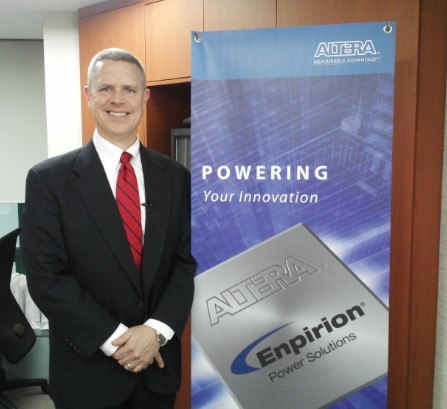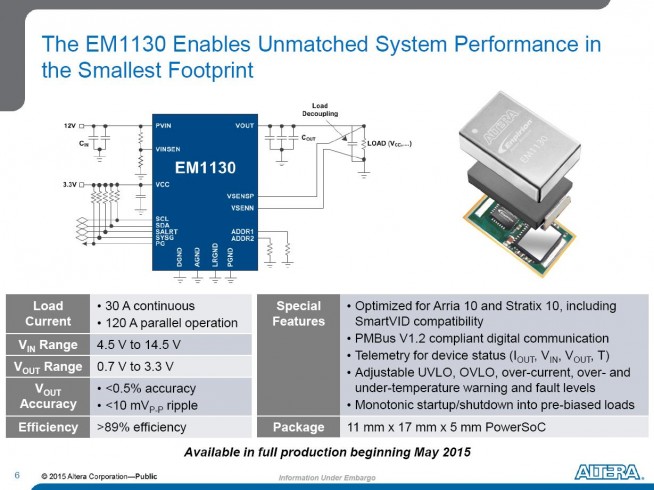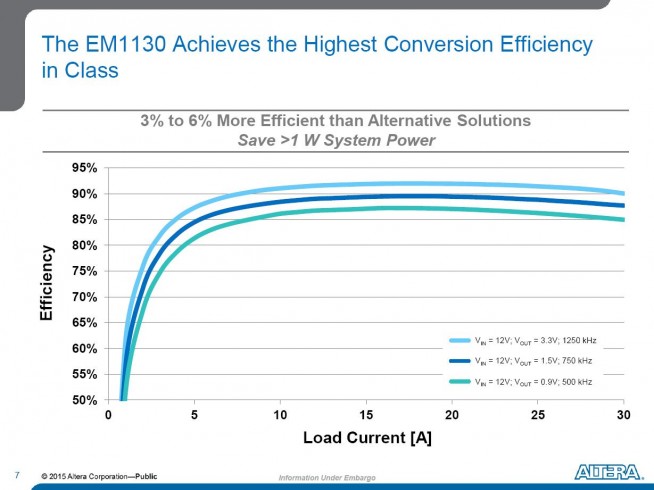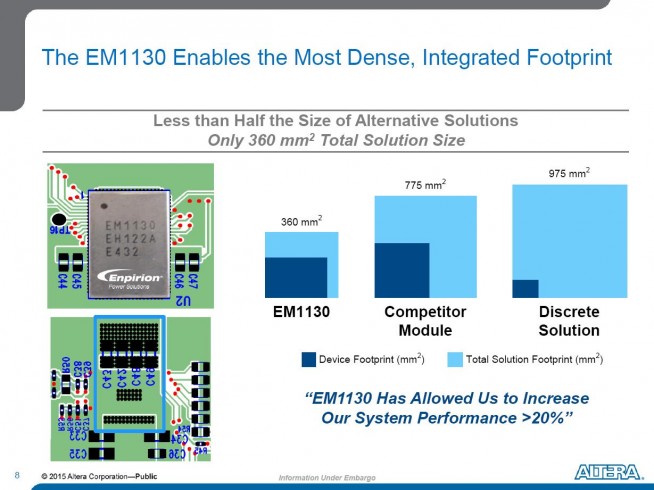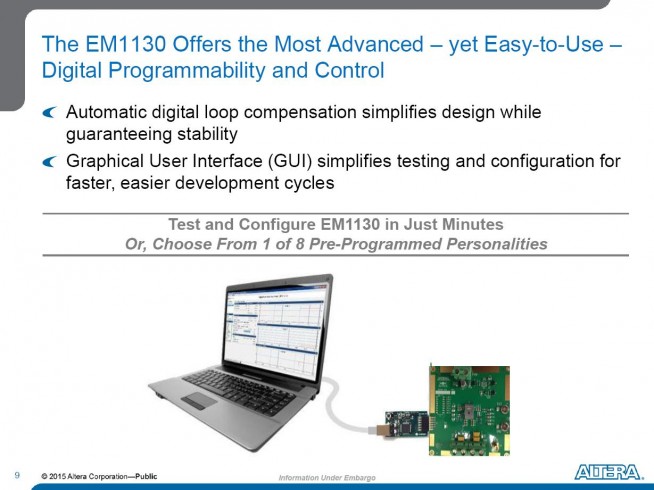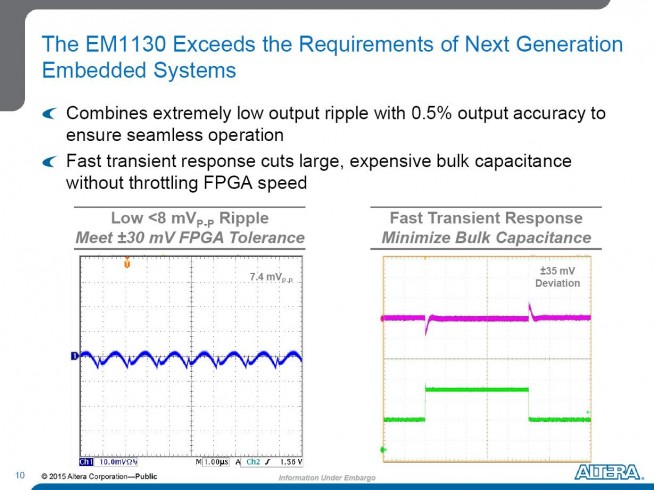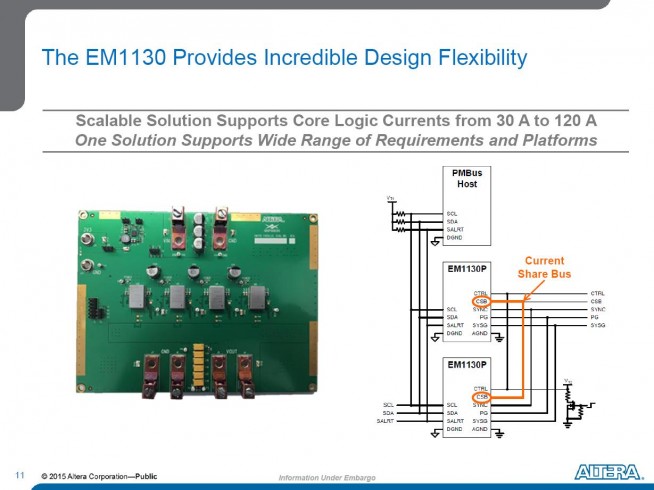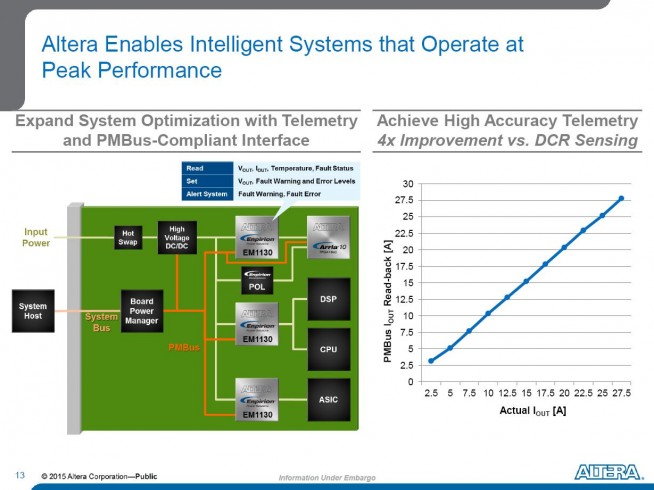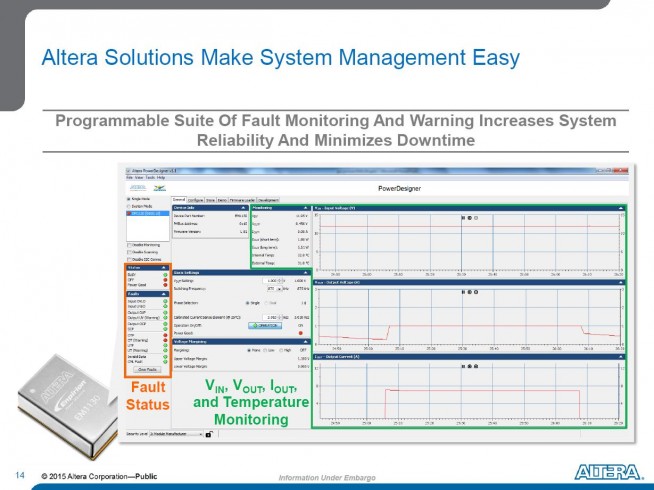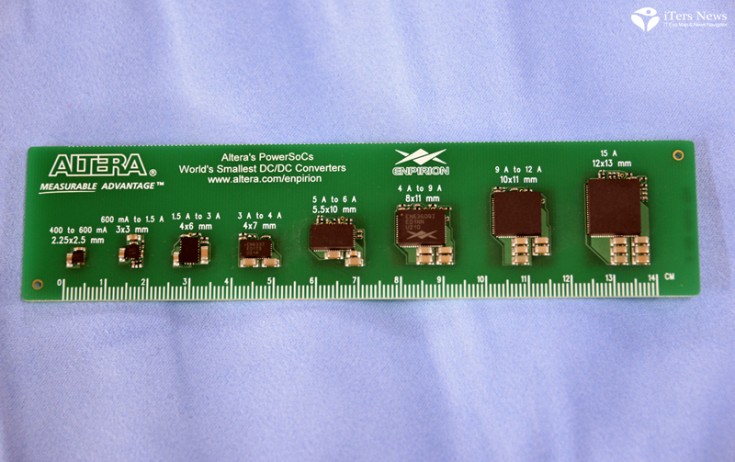(iTers News) - FPGAs, or field programmable logic gate arrays, and SoCs alike are increasingly becoming powerful in performances, faster in speed, and more challengingly, complex in its structure, rapidly evolving to add mixed functionality to their programmable fabric.
Accordingly, traditional analog power chip makers are confronting tough challenges in keeping up with this irreversible trend, struggling to reduce the silicon footprints of their power supply chips. But also, they are working hard to improve the energy efficiency of their chips.
Especially, system design engineers are on a look-out for smaller footprint, power-thriftier power supply chips not only to comply with the stringent power rail requirements of FPGA chips, but also meet the system power and thermal budget limits.
That’s where the forte of Altera Corp’s EM 1130 integrated 30 amp power module. Specifically designed to power Altera’s generation 10 FPGA chips such as Arria 10 and Stratix 10 FPGA cores and transceiver power supply rails, the EM1130 is the first product rollout of Enpirion digital PowerSoC DC-DC step-down converter technology since Altera acquired power management IC chip maker Enpirion, Inc. in 2013.
The rollout also represents a milestone step in Altera’s year-long efforts to bring unprecedented optimized power solutions to programmable logic market
The digital PowerSoC DC-DC step-down converter family was mainly developed for optimizing embedded system.
“Enpirion power solution is a key brand name within Altera in the market we serve. Enpirion products are ideally suited for powering FPGA and all of these FPGA family we provide today, “ said Patrick Wadden, director, worldwide power business development, power business unit with Altera Corp.
Added he, “FPGAs and SoCs are becoming more and more difficult to power with traditional analog solutions. The new FPGAs have an increasing complexity, speed and performance. Our new EM 1130 allows design engineers to simplify their designs by reducing costs and reducing board space. It enables unmatched system performances in small form factor.”
Ture enough. the EM1130 is a highly integrated power supply solution that comes built with PMbus, an inductor, and a driver. It come in 11mm x 17mm x 5mm package. The EM1130 offers the industry’s most dense footprint, and offers high, tight output regulation, and fast transient response. These features enable FPGA-based systems to meet the most stringent performance, power budget, and solution size requirements. PMBus provides the interface for Altera SmartVID technology which allows the converter to provide the Arria 10 and Stratix 10 FPGAs with a lower voltage (VCC) for significant power savings while maintaining the performance of the specific device speed grade. Additionally, the PMBus interface allows the EM1130 to communicate with the system to provide telemetry—measurement of key parameters such as current, voltage and temperature.
According to him, the EM11309 proves the best of its class in the energy conversion efficiency. Compared with other alternative solution, the EM1130 boasted of 3% to 6% improvements in the efficiency, resulting in dramatic decrease in the power consumption. Juts 1% gain in the efficiency translates in a power savings of 270 milli-watts, so that 3% improvements equals one watt in the power savings.
“The one watt power savings can help save approximately 15 and 30 dollars per year in energy costs. Devices like this in a data center with a hundred of boards could save 1.5 to 3 million dollars per year in the energy cost. This device is ideal for computing applications like servers in datacenters. We have already started to receive pre-production orders for the EM1130 from customer in industrial and communications space, “ he explained.
The EM1130 will start to ship in May
Smaller form factors are appealing to system design engineers, too. The EM1130 offers the most dense, integrated footprint in the industry. Take one of Altera’s customers for example. The company used to build FPGA module board with 4 Arria 10 FPGA cores and other power supply chips than EM1130. By using the EM1130, however, the company comes to build a FPGA module of the same footprint with five Arria 10 cores, as the smaller real estate EM1130 allows it to save space on its module board. That leads to more than 20% improvements in the module system performance, because it can allow the system maker to add one more Arria FPGA core to the board. The EM1130-built in FPGA module board is just half that of Altera’s competitors, just occupying 360 square millimeters (360㎟).
Easy-to-use, digital programmability and control
The power supply chip is easy to use, too, as it comes built with automatic digital loop compensation that simplifies design, and guarantees stability. This feature compensate for external components that degrade over the time and ensure stability for a longer-term period.
Altera also provides a graphical user interface, a sort of free tool on the its Web site, which can be used with IC2 C interface to program the EM1130. Each EM 1130 device can store 8 individual profiles for personalities. This allows customers to save costs and better manage inventory.
The EM1130 exceeds the requirements of a next generation of embedded systems and FPGAs. One of the most attractive features is its output accuracy that is 0.5%. Most of competitors’ solutions are 2 to 4 times higher than this. Another benefit with the EM1130 is the fast transient response which allows Altera to eliminate buck capacitance saving costs and board spaces.
The EM1130 provides a great deal of design flexibility for design engineers. This is a scalable solution that allows them to combine up to 6 EM 1130 chips in parallel achieving 120A.
“With this EM1130, you can parallel up to six, achieving 180 amperes of current. You can achieve up to 180 amperes in current. Six is the maximum. This current sharing device bus is a feature that allows design engineers to control the current on each of the devices,” said director Patrick Wadden.
The EM113 can reduce static power up to 40% with new Arria 10 SmartVID. Each Arria 10 FPGA operates at an optimal voltage which can be read by the EM1130 bus.
"This is another example of how we make FPGA systems better. This is an example of how the EM1130 can achieve 4 times improvements in accuracy. This type of advantage offer tremendous advantages to design engineers when planning for his design linear airflow and heat sinking all of those things," added director Patrick Wadden.
This is the snapshot of that GUI that is used to program EM1130. This free software program can be used to program voltage-in, voltage-out, current and temperature monitoring. This software’s fault managing and warning indicators prevent Altera’s customers from downtime and minimize their development time.
The EM 1130 is the first device of the digital PowerSoC DC-DC step-down converter family which will be released this year and next year. The additional devices which will be released will be networked with the EM1130 using the PM bus.
The EM1130 will be used with other FPGA makers’ solutions to power them. In addition, it is an excellent solution for other ASICs and processors which need this kind of stringent design requirements.


